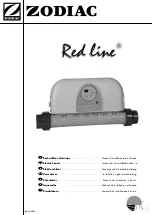
P
lanning
y
our
i
nStallation
i
nstaLLation
oF
R
eceiveR
:
Figure 20. Receiver Installation.
The Receiver is the heart of the remote control system. You need to access this receiver after installation to
change the batteries (for operation during a power failure), to program a new remote / receiver combination
and to operate a manual override should you lose your remote control or the batteries in the remote control
lose their power.
The Receiver is connected to the fireplace with a wire harness that has a maximum length of 8 ft (2.4m). The
connection point on the fireplace is on the right side of the unit, where the gas valve and electronic ignition
module is located. Because of the 8 ft (2.4m) limitation in the wiring harness, the receiver needs to be mounted
to the right side of the fireplace. An electrical box is provided for the receiver. Mount this electrical box as you
would any electrical outlet or switch box. Thread the cable and connector through the back of the electrical
box and connect it to the rear of the receiver. Secure the receiver into the electrical box. Once the facing of
the fireplace installation is complete, install the receiver cover, supplied with the unit as shown. The receiver
cover also functions as a switch plate and allows for access to the program button, critical for remote control
operation.
Review the section in this manual regarding the remote control operations for more information on the functions
of the receiver.
a
LLowabLe
v
ent
c
onFiguRations
:
The vent chart, in Figure 21, illustrates the vent configurations that have been tested and approved for use with
this appliance. 45˚ elbows are acceptable for this installation and may be used instead of 90˚ elbows. You may
use two (2) 45˚ elbows for every 90˚ elbow shown in this chart.
This appliance can be used with 5” x 8” venting in vertical termination installation with the used of Simpson 5”
x 8” reducer adapter.
The restrictor settings shown in Figure 21, are recommended. Installation factors such as altitude, prevailing
weather conditions such as temperature or wind, or the number of elbows used may affect your final restrictor
settings. Insufficient restriction may cause pilot outages or reduced efficiencies. Too much restriction may lead
to elevated operating temperatures, poor flame appearances, sooting or carbon deposits building up on burner
effects or window glass.
16
NOTE: Finish receiver install
after all other construction
to avoid damage
















































